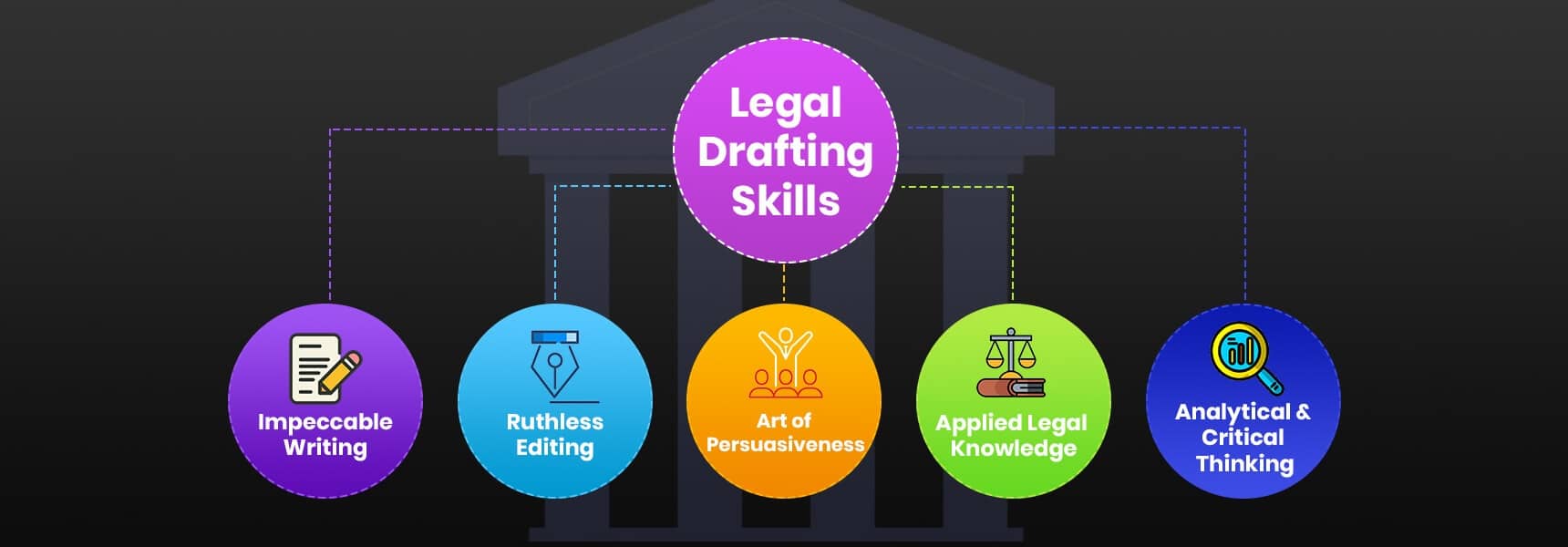Professionals in the legal industry swear by the maxim “verba volant, scripta manent”, which means spoken words fly away, written words remain.
Courtroom dramas might make you think lawyers only focus on oratory prowess and the art of persuasion. While both of them have a role in legal practice, they are still only a part of it. A large part of the business law practice involves the preparation of legal documents, which lawyers call “drafting.”
Often called one of the most intellectually demanding of all lawyering skills, legal drafting needs a lawyer to have multiple skills starting from a strong command over the language. A well-drafted legal document is like a strong argument before the judge!
If you ever search the phrase “legal drafting meaning” on Google, you will get a whole lot of information on the essential elements of legal drafting as well as the importance of legal drafting. With so many resources and each offering their own version of ‘drafting’ in legal context can prove intimidating to the uninitiated. This article will explain effective drafting skills and ways to build upon them.
So, what exactly is legal drafting?
Legal drafting, in its essence, is the synthesis of law and fact that can impact the parties involved. It offers a structured approach to develop any written legal instrument such as a contract, conveyance, memo, affidavit, petition, notice, etc. in a language form.
Legal drafting involves learning how to draft various kinds of legal documents to be presented in court as well as providing accurate and true statements for the benefit of the client. Drafting skills for different forums and different areas of law differ. For example, petitions before a criminal court will be very different in structure and approach from petitions before the National Company Law Tribunal (NCLT) or from arbitration petitions. Similarly, a shareholder’s agreement will be very different from an employment agreement.
Drafting a legal document involves identifying all the relevant facts and law, and then applying them to prepare a document. Being legally correct and staying relevant to the subject matter is the essence of legal drafting. A neatly drafted legal document should clearly express its purpose and applicability. It involves greater responsibility on the part of the lawyer than any ordinary writer.
The drafting process operates in two planes: the conceptual and the verbal. The right words must blend in with the right concepts. It calls for the expertise of a seasoned attorney and superior writing skills.
The Art of Creating Legal Documents
Starting from determining the client’s needs and identifying the best form for the situation to artfully crafting a custom contract by adding key information into relevant sections, followed by further refining the document to highlight or underplay certain provisions to echo the business cultures or focus of the parties – good legal drafting is more a form of art than a science.
A well-drafted legal document should tell your story persuasively. The language used should convey your arguments as cogently and clearly as possible. Every word written needs to be analyzed for its contextual meaning & impact. Every line ought to be vetted for its accuracy and effectiveness. There is no scope for a weak link when it comes to legal documentation. It can make or break your case in court!
It is not just about writing what you want to communicate; you also need to anticipate how it will be delivered and interpreted by the reader on the other side. Sometimes, you need to write down even what you
don’t intend to say – just to elucidate every conceivable interpretation on the other end.
While clarity is so important and you don’t want to leave any scope of legal ambiguity in the draft, things can quickly change. At times, you will purposefully leave some things ambiguous to lay traps with your effective drafting skills.
To draft effective legal documents, an attorney must:
– Understand the client’s specific needs;
– Identify the issues triggered by the project;
– Research the law relating to the issues;
– Apply the research to fashion your terms;
– Communicate the terms to your audience.
An aspiring legal draftsman or even highly experienced lawyers could benefit from using valuable resources such as legal dictionaries, form books, writing manuals, federal and states rules of procedure, and citation style manuals for drafting legal documents. Once you familiarize yourself with these legal drafting resources, your legal drafting process goes a lot smoother.
Effective legal drafting is essentially a blend of five top soft skills:
How Lawyers Can Improve Their Legal Drafting Skills?

Mastering legal drafting takes time and practice. Here’s how you can take steps to improve your legal drafting skills:
#1 Keep your audience in mind
You cannot convey your message effectively unless you don’t understand who you are addressing. Whether it’s the attorney, the jury, or the parties involved in litigation, your understanding of your target audience helps you to take the right approach. As a legal draftsman, your choice of words and tone should make sense to every party and further facilitate decision-making.
#2 Create a roadmap for your writing
Plan out the document before you begin. Your legal draft should educate, inform, and address the issue at hand directly while ensuring the most important sections of the document are easily accessible. Use of headings and subheadings to break large blocks of text, use of transitional phrases, and use of a topic sentence within each paragraph guide the reader to promote readability.
#3 Ditch unnecessary legal phrases and jargon
Legal documents often peppered with jargon conferred a false notion of precision. While it is important to use ‘legal terms’ while drafting legal documents so that parties involved understand what needs to be conveyed, it can make your writing abstract and archaic.
#4 Keep it simple and concise
Simplicity is a virtue in legal drafting. Always look for ways to simplify a complex argument or a complicated factual matrix so that it conveys the message with clarity in the most concise way. Concise does not necessarily mean brief, rather it is efficient. Refrain from using ambiguous words or phrases while maintaining consistency in the presentation of an idea for absolute clarity.
#5 Use powerful action words
Make your legal prose more dynamic and vivid using powerful action words. For example, “The defendant was not truthful.” gives a weak impression while “The defendant lied.” clearly sounds better.
Similarly, it is better to avoid words like ‘give consideration to’ (say ‘consider’), ‘is concerned with’ (say ‘concerns’), ‘make payment’ (say ‘pay’), and many more. These words are hard to read and make sentences longer while action verbs are shorter and more direct.
#6 Remember the chronology
A deep emphasis should be put on the chronology while drafting the details of an event. Everything needs to be accurate with precise details and in a logical sequence, thus reflecting an organized analysis of the event.
#7 Always Use Active Voice
A lot of writers suffer from this problem of writing in a passive voice. Using an active voice in legal writing eliminates confusion, clearly outlining who must perform what in a sentence. Passive voice creates a sense of ambiguity in your text. For example, note the clarity in “shall give notice,” as contrasted with “Notice shall be given.” The latter leaves in doubt who is to give notice.
#8 Edit and proofread the draft several times
Edit the draft to ensure it is error-free while omitting unnecessary words and rewriting for more clarity on a specific point. When editing your own work, it is advisable to take a break or come back the next day to make edits and tie up the loose ends. There is no scope for errors in terms of grammar and spelling as it will jeopardize your credibility as a legal professional.
Related Reading: Top 15 Tasks a Virtual Legal Assistant Can Do For You
The Do’s and Don’ts of Legal Drafting
Do’s of drafting:
- Use simple and familiar words with shorter sentences
- No ambiguity
- Use present tense
- Avoid legal jargon
- Use “shall” for the imperative and “may” for the permissive
- Prefer active voice over passive voice
- Write from the reader’s point of view
Don’ts of drafting:
- Avoid unnecessary repetitions
- Avoid using different words to denote the same thing
- Avoid cumulative negatives in one statement
- Avoid misplaced modifiers
- Avoid syntactic and contextual ambiguities
- Avoid spelling/grammatical/typing mistakes
Conclusion
As legal drafts are the cornerstone of any litigation, legal firms rely on experienced hands to write these documents. Performing legal drafting effectively is a tricky process that often takes years of practice to perfect. If you are not an expert on any aspect of legal drafts or want to cut down on costs, outsource document drafting services to a specialized vendor.
Virtual Employee specializes in legal drafting services where all lawyers are vetted and handpicked to ensure you get done everything right. The team has highly qualified law professionals that are trained to draft your legal documents effectively in adherence to strict deadlines and time limitations. Having worked for various law firms and corporate legal departments in the US and UK, our experienced attorneys can handle any type of task related to writing and drafting in legal practice. With the difference in time zones between India and the US or UK, clients can benefit from 24×7 services.
